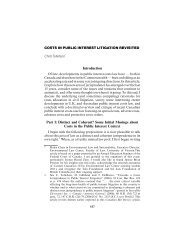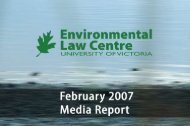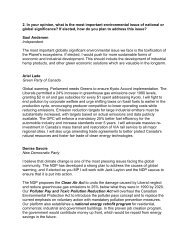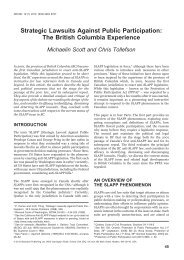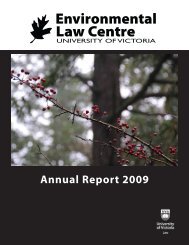Peeling back the Pavement - POLIS Water Sustainability Project
Peeling back the Pavement - POLIS Water Sustainability Project
Peeling back the Pavement - POLIS Water Sustainability Project
Create successful ePaper yourself
Turn your PDF publications into a flip-book with our unique Google optimized e-Paper software.
Photo: P. Lynch<br />
Flooding due to storm events,<br />
combined with insufficient drainage<br />
and lack of infiltration can<br />
cause roads to collapse, as happened<br />
on Toronto’s Finch Avenue<br />
(not shown) in 2005, which cost<br />
$45 million to repair.<br />
ment and governed by Health Acts or Drinking <strong>Water</strong> Protection Acts. Ano<strong>the</strong>r<br />
department is responsible for sewers while yet ano<strong>the</strong>r might deal with stormwater.<br />
In addition, a separate planning department deals with land-use decisions, such<br />
as zoning and community development, which directly impact local water resources.<br />
Individual municipalities are responsible for different aspects of <strong>the</strong> physical<br />
infrastructure, including pipes, pumps, and storm sewers, within <strong>the</strong>ir mutually<br />
exclusive boundaries. And senior governments have separate environmental responsibilities<br />
related to fisheries, watersheds, and water quality and quantity. The<br />
result is a complex patchwork of actors and legislation that creates a system with<br />
generally siloed decisions and often-competing objectives. Little attention is paid to<br />
cumulative impacts or whole-system function. Land-use planning is conducted and<br />
decisions are made on <strong>the</strong> basis of municipal boundaries or property ownership—<br />
nei<strong>the</strong>r of which have much to do with ecological systems.<br />
As described, <strong>the</strong> responsibilities for stormwater management flow through local<br />
government and are executed through land-use planning tools, such as regional plans<br />
including integrated liquid waste management plans, community plans, zoning bylaws,<br />
and site-specific development standards and permits. Local governments may<br />
also be responsible for managing and protecting <strong>the</strong> local environment, which <strong>the</strong>y<br />
typically do through regulatory powers, such as tree protection and soil erosion and<br />
deposit bylaws. In some cases, <strong>the</strong>se stewardship powers are extended to include<br />
additional regulatory authority over watercourse protection and pollution prevention<br />
through, for example, pesticide bans. Even with <strong>the</strong>se tools and best “past” practices<br />
in place, <strong>the</strong> Stormwater City does not, in practice, fully protect ecosystems and<br />
water resources. Ineffective and disconnected governance is at <strong>the</strong> core of this problem.<br />
Changes must be made to our existing institutional structures and governance.<br />
Changes must be made to how we think and make decisions about rainwater in <strong>the</strong><br />
context of our communities with a clear focus on functioning rivers, streams, creeks,<br />
wetlands, and lakes as parts of a healthy, resilient watershed.<br />
13



